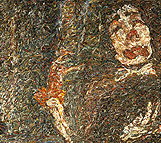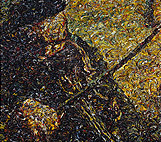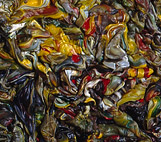Reviews
"Berthe Hess had already been heralded by discriminating critics for her unique, extraordinary work. It would be wrong to describe what she does as painting; it is more sculpture in paint.
The paint is applied lavishly, often it is well over an inch thick, so that her images are as much moulded as depicted in two dimensions.
But her work loses no detail or accuracy in this painstaking, weighty process. Every canvas echoes with sparkling light and an iridescent maze of colour which penetrates to the deepest of the grottos and hollows formed by the paint.
The figurative image on which all works are based comes across through the physical light and air which is captured by the canvas. Each work seems to enter into a richly rewarding dialectic with the environment in which it is placed, capturing, rejecting, metamorphosing the light which falls upon it in a thousand different ways.
This unique effect is achieved through the vast surface area of paint exposed, far more than would be possible in a normal painting of a comparable size.
The result is that though she bases her work on objects as seen, she completely transcends the deception inherent in normal perspective painting by seizing the third dimension, and dragging it bodily onto canvas.
Thus, "le Berthisme", manages to retain the strength of the sculptor, with a relish in materials, and the delicacy and lightness of touch of the painter.
As one walks past the pictures, they change radically. As in sculpture, each viewpoint offers a different work, shimmering with a new and vivid interpretation of the light which falls upon it.
Berthe Hess creates with meticulous care; she only works on one picture at a time, and spends many weeks on each. But the end result is worth every moment of effort. Each canvas is a triumph, a superb and highly original work. Taken together, they are more than that: they are a real contribution to the art of this century."
Peter Fuller, The City Press, 1969.
"...The oil paint is applied thickly, forming a surface resembling, at close quarters, a field of thick long grass beaten down by torrential rains. Colour is applied in small pulled strokes of such infinite graduation that it is quite impossible without intensive study to understand how it achieves its structural effect. In close-up, these paintings are bewildering, shredded surfaces of interpenetrating colour, with here and there a deep groove running away from the eye, like a Martian 'canal', evidently purposive but mysterious. One draws back a few feet and the picture changes, becomes in fact a picture. 'Bertisme' gives to the subject-matter a curtaining effect, like very fine pinpoints of rain upon glass, and through this, as if a space of air lay between, the picture is seen, undistorted but remote in its own atmosphere...."
Richard Walker, Arts Review, July 1968
"... Her use of colour is incredible, a blue sky is at first a blue sky, but stand up close and you will see that it contains every colour of the rainbow and a few more besides.
Each work reeks with the atmosphere of the subject painted, and because of the texture of the surface of her work the image that one sees seems to hang in space. Berthe Hess works not in two dimensions but in three!
It could be said that she does not paint objects but the colour and texture of the air between the viewer and the subject and the reflected light therefrom.
The output of this artist is limited in quantity by the difficulty of its execution. It can never be copied, imitated or forged, and one square inch of surface could not be reproduced even by the artist herself.
The technical problems of making adequate prints of this work are enormous, and as only a handful of her works will ever be sold their rarity value will be considerable.
Mrs. Hess -'Bertisme' in art circles - evolved her technique nearly 30 years ago and has worked at her canvases almost daily ever since. In all, she had produced 160 works and today her paintings fetch from £400 for a miniature to £30,000 for a major creation.
She has now opened her own museum, near St Paul's Cathedral, which is the first museum in the City. Its establishment followed the offer of a State-financed museum in France, her native country, and requests for 27 museums in Britain and abroad for her acknowledged masterpieces.
These she turned down because she does not want her life-long works dispersed. They are the only ones of their kind and she preferred to safeguard them under one roof in London, where she chooses to live with her husband and daughter..."
From Buying Antiques Vol 1, issue 6, 13th July 1973
"At the B.H. Corner Gallery in Paternoster Square, facing St. Paul's Cathedral, a most remarkable exhibition of work under the name of Bertisme is to be seen. These are oils painted by Berthe Hess in a manner of her own invention. At close quarters, each canvas looks as though it had been covered with ply upon ply of painted wool, into which had been woven minute flecks of color. Stand back, however, and the subject, the "Quai des Célestins", say, or a gardian in the Camargue, emerges radiant in an atmosphere one can well nigh breathe."
Max Wykes Joyce, New York Herald Tribune, 27th December, 1969
"The paintings of I.J. Berthe Hess make their own terms. There is no attempt to compromise with what is in vogue. In fact the artist is so individual that she has invented her own technique of thousands of quick strokes of paint, applied with what Henry James called "the mysteries of ministrations of rare pieces", to create a picture which one can see into. One does not have to read meanings into a puzzle; one looks and waits and the representation appears in the novel use of images. Their world is around us as we descry their formal and efficient cause. Was it not Ruskin who said that art should be the revelation of the spirit of the whole man? We have forgotten such commitment in an age of gimmick, but Berthe Hess reminds us of its rewards and unique achievements..."
Oswell Blackstone, What's On In London, October 2, 1970
"The picture illustrated, La Récolte, is a characteristic example of 'Bertisme', a unique style of painting evolved by Berthe Hess. The paint is applied lavishly, sometimes up to two inches in depth, but it is put on in short, sharp strokes in an iridescent maze of colours. The particular effect this produces is sculptural in quality. The grottoes and caves created by the paint, capture the light from a thousand different angles: the exposed surface is far greater than would be possible in an ordinary picture.
This leads naturally to a suspended image: the picture exists somewhere between the viewer and the canvas; it cannot be distinguished close to.
A remarkable feature of her work is that she is not content with a general, atmospheric interpretation but catches the minutest details of gesture and landscape and holds them, reverberating through inches of paint.
One can feel this unique quality in her treatment of the potato plants, and in the hunched figure of the background worker in this picture.
However, technique is never enough. With her technical sophistication, Berthe Hess has a warm and sensitive vision of human life which belies the intense labour and effort involved in the creation of her pictures. (They take many months to make and many more years to dry. The sheer weight of pigment involved is amazing.)
Whether she is painting dancers, boxers, night-club artistes or peasants in a landscape; the approach is the same. The outstanding feature of her work is the discovery of an entirely new method of painting without loss of a personal, poetic vision of life. Despite the arresting, vigourous and bizarre tensions created by her technique, sympathy, relish and intimacy, so characteristic of French painting, simply pour from her work."
Peter Fuller, The Connoisseur, January 1970.
"Through all the fashions and changing waves of taste there has always run a virile artery that carries with it those painters who are so much one with their medium that they are able to use it to the limit.
To Rubens the rich buttery quality of his paint provided a fluid vehicle for his intense emotion. Utrillo, by his understanding of the varying qualities of oil paint, could simulate the gentle pleasant loving decay of the back-streets of Paris.
A painter with us today is Berthe Hess, who has evolved a highly personal style that is nevertheless closely coupled to this 'understanding of medium'. Berthe Hess with her brushes and coulours excites a pattern of rich heavy prickly impasto upon her canvases that in the final estimate achieves a strong feeling of atmosphere; an amosphere that is alive, almost crackling with sensation. The paint strokes appear at times as stabs at the canvas and leave behind them an impression of a rugged tapestry, a tapestry that is moving, swept by unseen winds. She achieves a strange feeling of gentleness and of the peace that can so often go parrallel with a moment of spending their lives outside.
John FitzMaurice Mills, The Irish Times, May 19, 1970
"SOME artists - even the very great ones - thrive on ambiguity and deliberate obscurity. Picasso admitted to tweaking the nose of his credulous public upon occasion; in an interview in 1952, he spoke with uncharacteristic candour of "all the changing oddities which passed through my head, and the less they understood me the more they admired me. By amusing myself with all these games, with all these absurdities, with all these puzzles, rebuses, arabesques, I became famous - and that very quickly . . . and today, as you know, I am celebrated, I am rich." At least Picasso was a joker of genius; an artless public seeking to become artful are not always so lucky. In an era when many artists have opted to become celebrities and pop stars, the few who remain constant for something above and beyond mere faddishness or cleverness tread a lonely path. Berthe Hess is one of these determined idealists.
Despite, the romantic aura which cloaks the painter, his life is hardly less prosaic than our own. Like us, he has to pay for the rent, heat and light-and often his prolific output is dictated by the hard financial demands of a gallery. The painter who discovers the key to the public fancy, who hits upon a winning formula and patents it, has won a Pyrrhic victory. Too often, the immediacy which must characterise really great art subsides into a tired repetition of sure-fire themes; the aim becomes increasingly steady but the impact correspondingly weak.
Berthe Hess has succumbed to none of these hazards of success. A painter who is already enshrined in her own museums - one in London and one in Paris - her rigorous devotion to her cause, "Berthisme", insures that her inspiration does not become stultified - or overwrought with clandestine "meanings". In return, her vigorous sincerity has found remuneration in both academic and investment circles. From £400 for a small jewel of a painting - a vase of flowers, a shadowy dancer, a pale sailboat in a thick dusk of interming1ing brushstrokes - to the £30,000 asked for one of her large canvasses La Chasse, perhaps the red-frocked hunting party gamboling through a dappled autumn landscape - the figures merely attempt to put into perspective an art which is above fashion and fortune. But the man who pays the price is hardly fortune's fool - six years ago her largest scenes were bringing only £750.
An attempt to describe a style of painting in the medium of words is a perilous task, and "Bertisme" resists categorising with more, than usual persistence. But the writer must take his challenges in the same spirit as the painter, and so he tries. A simple explanation of "Bertisme" could begin by calling it Impressionism taken one step further. Based on a loose marriage of theories garnered from Pissaro and Manet, it utilises thick threads of paint, clustered one on top of another, like pile in a carpet. Ten different hues can be found in one inch-thick stroke; like the true Impressionists of old, she captures not so much the line and substance of an object, but the entire glimmering texture of light hanging in the air in between the painting and the astonished eye. Sometimes three inches deep, a work in "Bertisme" requires hundreds of pounds worth of paint, a, year to finish and two years to dry. A painting's crags and peaks, Chasms and variegated veins of interwoven colour are truly sculptural in quality, but they claim an added dimension of time and movement through the ever-changing tricks of sight - forms and colours which leap out of the picture and then retreat into shade once the gaze has shifted.
The gradual evolution of her style over a 20-year period, and the infinite patience which is necessary to complete each 20-pound mass of impasto, ensures that there can be no such thing as a forgery of a Berthe Hess painting, The manner in which each globule of paint incorporates innumerable but separate hair-threads of pigment is itself an art which has taken years to perfect. It is Britain's gain that Mrs Hess has chosen to perfect it here. A French-woman, who with her husband and daughter has adopted, this nation as her own, she finds that Britain itself provides matchless a model and an open-ended studio, Barges on the Thames, Saint Paul's, the hunt, ,the roaring grey sea are all subjects which Britons know and love and which her brush translates into scenes that are at once familiar and magically different. Unlike Picasso, she does not caper, pull our leg, tweak our ears and then ask us to worship artifice as well as art. Her sincerity and crystalline directness are above such devices; there are no "periods" or "isms" other than her own "Berthisme". Picasso was king - and Jester - and I know the king is dead. Long live the queen!"
Eleanore Best, "The World of Berthe Hess", Investor's Review, 29th June 1973
The only official website designed and developed by the family of I.J. Berthe Hess. Copyright 2013






